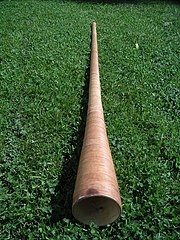Lur
This articleneeds additional citations forverification.(June 2011) |


Alur,alsolureorlurr,is a longnatural blowing hornwithout finger holes that is played with abrass-type embouchure.Lurs can be straight or curved in various shapes. The purpose of the curves was to make long instruments easier to carry (e.g. for marching, like the modernsousaphone) and to avoid directing the loud noise at nearby people.
The nameluris used for two distinct types of ancientwind instruments.The more recent type is made ofwoodand was in use inScandinaviaduring theMiddle Ages.The older type, named after the more recent type, is made ofbronze,dates to theBronze Ageand was often found in pairs, deposited inbogs,mainly inDenmarkandGermany.It consists of a mouthpiece and several pieces and/or pipes. Its length can reach between 1.5 and 2 metres. It has been found inNorway,Denmark,South Sweden,and Northern Germany. Illustrations of lurs have also been found on severalrock paintingsin Scandinavia.
Wooden lurs
[edit]The earliest references to an instrument called the lur come fromIcelandicsagas,where they are described aswarinstruments, used to marshal troops and frighten the enemy. These lurs, several examples of which have been discovered inlongboats,are straight, end-blown wooden tubes, around one metre long. They do not have finger holes, and are played much like a modernbrass instrument.
A kind of lur very similar to these war instruments has been played byfarmersand milkmaids inNordic countriessince at least theMiddle Ages.[2]These instruments, called in English abirch trumpet,were used for callingcattleand signalling. They are similar in construction and playing technique to the war instrument, but are covered inbirch,while the war instruments are covered inwillow.
Bronze lurs
[edit]Lurs made of bronze were used as musical instruments in ancient Greece, as well as in northern Europe where a total of 56 lurs have been discovered: 35 (including fragmentary ones) inDenmark,11 inSweden,4 inNorway,5 in northernGermany,and a single one inLatvia.
Lurs today
[edit]The wordluris still in theSwedish language,indicating any funnel-shaped implement used for producing or receiving sound. For instance, the Swedish word forheadphonesishörlurar(hearing-lurs), and atelephonemight be referred to as alurin contemporary Swedish (derived fromtelefonlur,telephone handset). The Norwegian and Swedish words forfoghornare respectivelytåkelurandmistlur.The Danish butter brandLurpakis named after the lur, and the package design contains pictures of lurs.
The wordlurhas several other meanings in Danish, Norwegian, and Swedish that are not related to sound.
See also
[edit]References
[edit]- ^"Bronze lurs - The Brudevælte lurs".Archived fromthe originalon 2011-09-27.Retrieved2007-10-21.
- ^"The Wooden Lurs".ojtrumpet.net.Archived fromthe originalon 2019-10-11.Retrieved2019-10-11.
